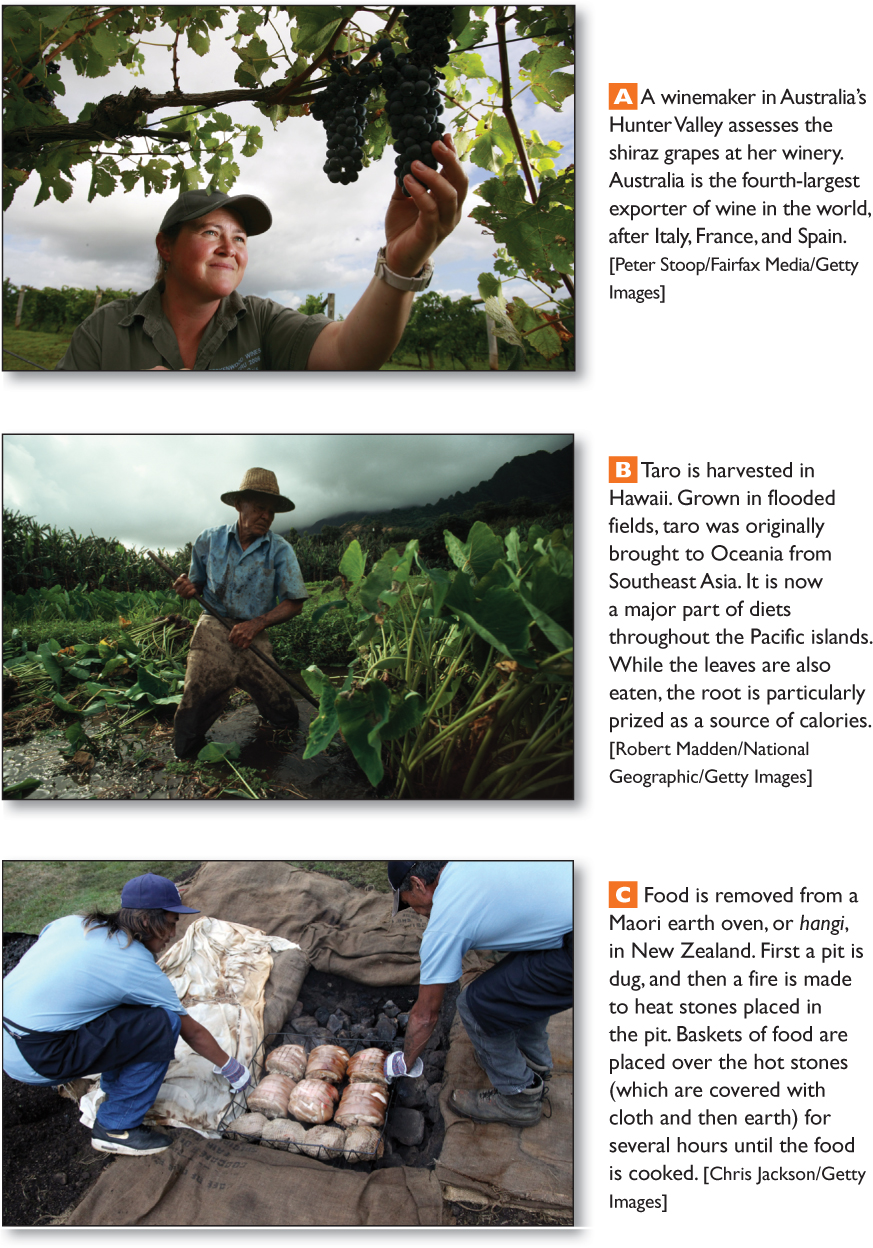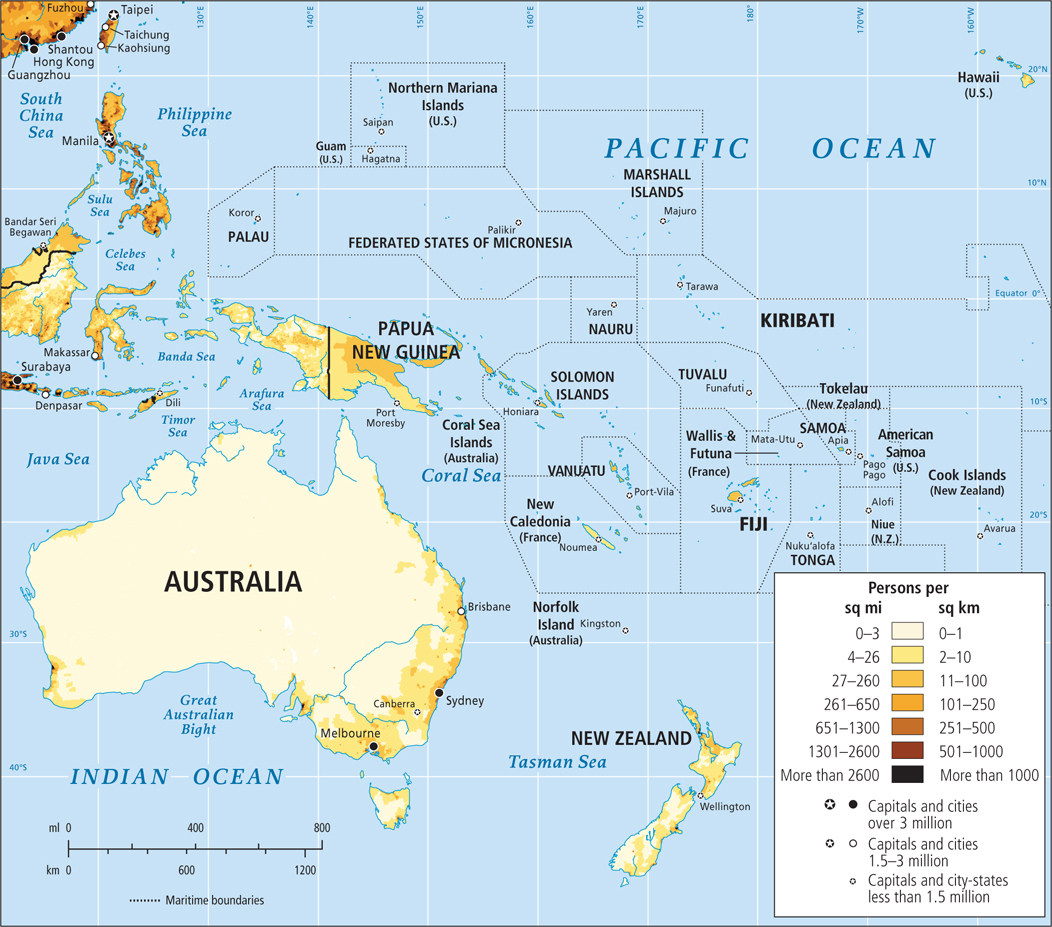11.8 POPULATION AND GENDER
GEOGRAPHIC INSIGHT 5
Population and Gender: In this largest but least populated world region, there are two main patterns relevant to population and gender. Australia, New Zealand, and Hawaii have older and more slowly growing populations, and relatively more opportunities for women. The Pacific islands and Papua New Guinea have much more rural, younger, and rapidly growing populations, with fewer opportunities for women.
A number of factors are influencing population growth in Oceania; among them are issues related to gender. While there is a trend toward equality across gender lines throughout Oceania, there is persistent gender inequality as well. A striking disparity is emerging between Australia and New Zealand (where women are gaining political and economic power) and Papua New Guinea and the Pacific islands (where change is much slower).
In Australia and New Zealand, women’s access to jobs and policy-
In both Australia and New Zealand, young women are pursuing higher education and professional careers and postponing marriage and childbearing until their thirties. (This is also a trend in Hawaii, Guam, and the islands with French affiliation.) Nonetheless, both societies continue to reinforce the housewife role for women in a variety of ways. For example, the expectation is that women, not men, will interrupt their careers to stay home to care for young or elderly family members. Women in Australia receive, on average, only about 70 percent of the pay that men receive for equivalent work. This is, however, a smaller gender pay gap than in many other developed countries.
Throughout Papua New Guinea and the Pacific islands, gender roles and relationships vary greatly over the course of a lifetime. Because of the emphasis on community, male and female Pacific Islanders contribute to family assets through the formal and informal economies. Traditionally, men are the boat builders, navigators, fishers, and house builders. And they are usually the preparers of food, though women often supply some of the ingredients through their gathering and cultivating efforts (Figure 11.19). Most traders in marketplaces are women, and, aside from fish, the items they sell are also made and transported by women. Many young women today fulfill traditional roles as mates and mothers and practice a wide range of domestic crafts, such as weaving and basketry. In middle age, however, these same women may return to school and take up careers. With the aid of government scholarships, some Pacific Islander women pursue higher education or job training that takes them far from the villages where they raised their children. Thus, the expectation that Aurora (in this chapter’s opening vignette) will study far from home and then support her family and elders is in line with evolving gender roles in Pacific ways of life. Aurora can expect that with age and accumulated experience, she will be boosted into a position of considerable power in her community.

Population Numbers and Distribution
Although Oceania occupies a huge portion of the planet, its total population is only 38.7 million people, close to that of the state of California (38 million) (Figure 11.20). The people of Oceania live on a total land area slightly larger than the contiguous United States but spread out in bits and pieces across an ocean larger than the Eurasian landmass. The Pacific islands have nearly 4.75 million people, including Hawaii’s 1.74 million; Australia has 22.7 million; Papua New Guinea, 6.9 million; and New Zealand, 4.4 million.

Population densities remain low in Australia, at 7.8 people per square mile (3 per square kilometer) for the country as a whole and about 50 per square mile (20 per square kilometer) in Australia’s settled southeast. New Zealand’s density is also low, at 41.4 people per square mile (16 per square kilometer). In the Pacific islands, densities vary widely. Some are sparsely settled or uninhabited, while others—
THINGS TO REMEMBER
GEOGRAPHIC INSIGHT 5
Population and Gender In this largest but least populated world region, there are two main patterns relevant to population and gender. Australia, New Zealand, and Hawaii have older and more slowly growing populations, and relatively more opportunities for women. The Pacific islands and Papua New Guinea have much more rural, younger, and rapidly growing populations, with fewer opportunities for women.
New Zealand and the Australian province of South Australia were among the first places in the world to grant European women full voting rights (in 1893 and 1895, respectively).
In both Australia and New Zealand, young women are pursuing higher education and professional careers and postponing marriage and childbearing until their thirties.
In some Pacific islands, women can inherit or personally accrue considerable power in their own communities over the course of a lifetime.
Although Oceania occupies a huge portion of the planet, its total population is only 38.7 million people, close to that of the state of California (38 million).